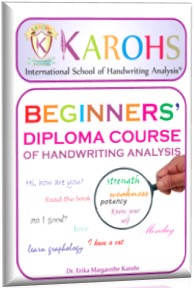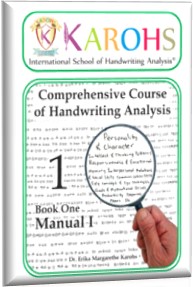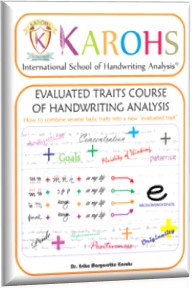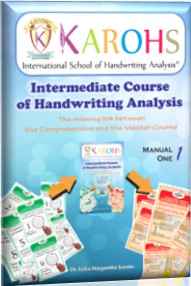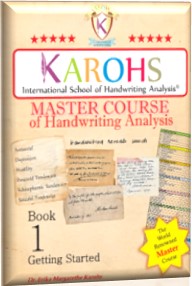Free Article about Handwriting Analysis
From “Sunday Lessons III”
- Sunday Lesson #11: Double Curves
By Dr. Erika M. Karohs
We have to thank Margarete Ivanovicfor the discovery and interpretation of double curves. She had an unequaled perception of uncommon graphic indicators (she also discovered the “air stroke” or “immaterial stroke”).Double curves can provide much insight about a personality. Unfortunately, these significant indicators are widely neglected because (a) not much is written about them in the more popular graphological works and (b) recognizing them takes a trained eye and thorough knowledge of the graphological meaning of the various configurations. Once graphologists have familiarized themselves with these signs, however, they will realize how much additional information they can glean from them for a much more thorough analysis. Double curves are delicately curved lines consisting of either:
- one convex and once concave portion
- one concave and one convex portion
- two concave portions or
- two convex portions
The direction can be vertical, horizontal, leftward, or rightward.
Important! The double curve has to be an individual addition to a letter. It cannot be part of a copybook letter formation; for instance, the letters S or L are not comprised of double curves.
Double curves of creativity and music
The musical and the creative curves consist of one smaller convex and a larger concave curve.
![]()
The musical and creative curves are similar, except that in the creative curve pressure is on the larger curve, in the musical curve, pressure is on the smaller curve.
creative musical.
Creative :
Musical:
![]()
Double curve of creativity
The writer has the ability to create without precedent. His mind functions inventively, reaching conclusions that are not the norm. He has an original approach to things and puts his personal stamp on whatever he does. He adds creative thinking to his work. His creativity may be expressed in small ways or on a larger scale. His need for self-expression may find an outlet in the creative field, and he is probably gifted in poetry.

Double curve of music
Musical aptitude is indicated by this formation. If they writer does not have musical talent him/herself, he will show appreciation for the musical field.

Double curve of insincerity
According to Magdalene Ivanovic, the double curve of insincerity consists of two unrelated curves.
![]()
These formations are additions to the letter formations. They are not part of the actual letters themselves. While ideally these signs should be supported by additional evidence in the writing they are strong evidence of insincerity by themselves.

The writer is an individual who intentionally deceives and misleads people with whom he deals. He deliberately tries to obscure his real intent from others. He hides and misrepresents and he may lie and evade the truth. There exists a real risk in dealing with him. His leading motivation is for personal advantages at others’ expense.
Double curve of pretense
![]()
The double curve of pretense also consists of two unrelated curves. Once graphologists are aware of this indicator, they will be surprised at its frequency in handwriting. Double curves of pretense can occur in initial or final position. The eight different possible positions of this formation are:
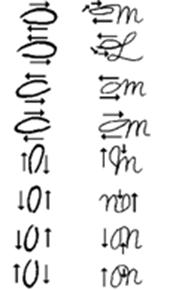
Basically, the writer feels less than others around him. To counteract this, he often name-drops, or boasts. His basic fear is that someone would see through the facade and detect his inner insecurities. He does not want anyone to discover how he truly feels about himself. In an effort to hide his inferiority he conceals the feelings of inner helplessness. He puts up a false front to keep others from seeing him as he really is.
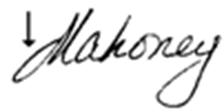
The writer gives himself an air of importance he does not possess and makes a frantic attempt to project an appearance of fortitude. Because he feels inadequate, he puts on a show of extra determination for all to see. He uses this form of pretense to handle threatening situations without losing face.

He may try to intimidate with idle warnings that he cannot follow up on. In order to gain advantages for himself, he may be saying one thing and doing another. He may be using excuses or alibis to avoid liability. In any case, he cannot be counted on to act in good faith. Others have to take everything that is said with a grain of salt.
Double curves of tact
Double curves of tact consist of two even-sized related curves.

Double curves of tact can occur in initial or final position in letters or words.

The writer possesses an instinctive mastery of the art of diplomacy. He has an intuitive sensitiveness for the feelings of others, the skill of not hearing certain things that could cause others embarrassment. At all times, he is tactful in dealing with people. He does exactly what is suitable and possesses the skill of saying the proper thing to avoid giving offense. He conserves energy by avoiding friction during social encounters and he makes situations smooth and comfortable for all involved.
The writer reflects before speaking and expresses himself in such a way as to decrease apparent threat. He says and does what lessens friction and prevents others from losing face. He can appease opposing sides and settle disagreements on the job. He is skilled at smoothing things over between irate customers in a store, for example, or between two workers who are at odds. He gets along with both superiors and peers. He shares his ideas without upsetting those whose support he needs. This is valuable were feelings and egos are involved. As a perfect host, he tries to seem interested in the conversation of his guests even if the topic does not captivate him at all.
The writer would make a natural arbitrator. Tact would be a valuable quality in social service work or sales. He could be a nurse, doctor, teacher, or funeral parlor employee.
Literature:
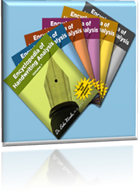 Erika M. Karohs, Encyclopedia for Handwriting Analyts, Pebble Beach, CA. 1986.
Erika M. Karohs, Encyclopedia for Handwriting Analyts, Pebble Beach, CA. 1986.
Margarete Ivanovic had a rare ability for the discovery and interpretation of unusual graphic indicators, such as the air or imaginary stroke. Among her most noteworthy discoveries were the single, double and expanded curves. as well as the combination of certain horizontal and straight strokes. Even though these unique structures have an important meaning, they are rarely mentioned in other graphological works. For detailed information see: Erika M. Karohs, Encyclopedia for Handwriting Analysts, volume XI (Pebble Beach, CA: self-published), p. 1113.
See listing “Expanded curves,” “Single curves,” Horizontal strokes,”, “Pointed angles,” “Right angles,” and “Straight strokes.”
See detail courses programs (click the image below):
Copyright © 2018 the KAROHS International School of Handwriting Analysis®. All rights reserved.
No image or portion of this website may be copied or reproduced without written permission.
Dictionary of Personality Traits As Seen in Handwriting
Most students have to refer to their course manuals for the illustrations and definitions of personality traits. This means that they have to turn on their computers or spread out two large volumes on the table just to check a certain personality trait. The dictionary decrease the time to check on traits. The Dictionary describes and illustrates 133 basic traits. It is the perfect reference work. If you are doing an analysis, just open the Dictionary and in no time you will have identified all of the traits in your handwriting sample. Illustrated.
Info: 1 Volume; 62 Pages Price: $29 Note: BONUS material in Beginner andComprehensive Course Program
HOME
Click here to back to KAROHS Home Page
COURSE
Click here to see our Course Programs
BOOKS
Click here to see our Books Store
Copyright © 2018 the KAROHS International School of Handwriting Analysis®. All rights reserved.
No image or portion of this website may be copied or reproduced without written permission.


